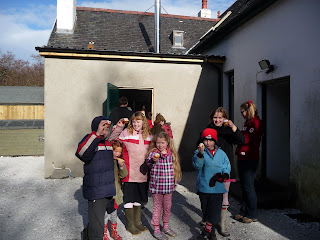 Despite a day of squalls and showers, there was a healthy turnout for the open house at Strathaird.
Despite a day of squalls and showers, there was a healthy turnout for the open house at Strathaird. The log boiler
house, focus of the 'opening' , was crammed full of people of all ages. Pupils from Elgol Primary attended and were knowledgeable and interested in matters relating to renewable energy - that is until the home baking appeared - at which point, all attention was diverted. But not before they had heard from "Clean Sleat" - a neighbouring community - about their endeavours to reduce their carbon footprint. It turns out the most effective things they have done have been to insulate homes and switch to wood for fuel.

The recently installed log boiler that serves the two properties owned by the John Muir Trust will help reduce the footprint of the Trust. However insulation still remains the most cost
effective measure.
One property is home to a family and the other is the office base and occasional base for visitors. Both buildings are poured concrete and, despite the thickness of the walls, they leak heat.
As a way of dealing with this leakage, some solid wall insulation has been applied to some walls in the family house. We used a material called 'sempatap'. It is like a thick wallpaper that is put straight onto walls with a glue like substance similar to copydex. This, according to Drew who lives in the house and put it up is, 'a bit of a pig to handle'. Once it hits the wall it sticks so two rather than one pair of hands would definitely help.' But does it make a difference?

George, Drew's 11 year old son who lives in the previously cold extension room, having sempatap has definitely made a difference.
"My room is a lot warmer now and I'm not cold when I get up in the morning anymore.
The log boiler is much better. In the kitchen, the oil boiler used to roar away and make a racquet and now it is very quiet and we are much warmer. I like being in the boiler room. It is nice and warm. I help stack the logs and wheel barrow them and I also help split them."
The objective evidence supports what George says. We took thermal imaging pictures before and after insulation and it was clear that loft insulation was most effective but that there was also a difference with the solid wall insulation. The Purple tells us heat is retained (right picture) - yellow tells us it is leaking heat (left picture). See previous blog.


And the log boiler - does it make a difference? It will certainly reduce the carbon footprint considerably, assuming the trees burnt are replaced. It is an expensive bit of kit but has a long predicted life and could have heated 3 properties. It has an impressive efficiency rate of 92% and only needs loading once a day to heat the properties and probably less in warmer months. ESSENTIAL to its effective functioning is DRY wood as that burns most efficiently.
Alastair Robertson from Highland Eco-Heat who fitted it reckons that it will payback its costs in 5-6 years. This assumes that the cost of oil will keep rising, that the wood is free and that we can access the renewable heat incentive, all of which seem likely. But the capital of £28K plus is quite a serious consideration for anyone. When we set out down this road - it seemed that there would be continued interest free loans for renewables. Then they were withdrawn. Then there was talk of loans that would go with the property rather than the owner so that repayment would be assigned to the value of a property rather than being something for the owner to be left to deal with but all has gone quiet on that front too.
The cost reflects the quality of equipment which we expect to last at least some 20 plus years. It is worth noting that the accreditation scheme for installation doesn't accredit the quality of the equipment as such and it is still in the UK a new area so lots to learn. We have been lucky in finding a reliable local installer on Skye who has researched equipment for us. The Trust is in many ways acting as a guinea pig for this. A bold move. Will it make a difference?
In the long run, this is certainly one way for people to go in rural areas where they have ready access to wood for fuel. More co-operation in how we approach issues like heating homes could also make this manageable as a boiler heating several properties would be cost effective. The idea of 'district heating systems' where one larger piece of kit heats several properties in not new. Much of the continent functions effectively on this basis and we could too - if only we could find a way to co-operate in these matters. Perhaps a time will come when this will be feasible for more places. Meantime, a small difference is being made in this corner of Scotland and aspects of that are replicable. Especially the basic insulation measures.



